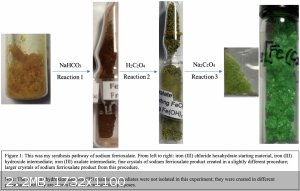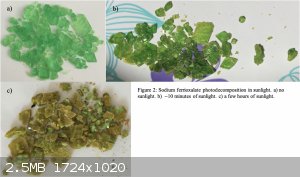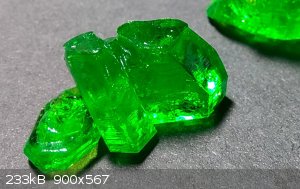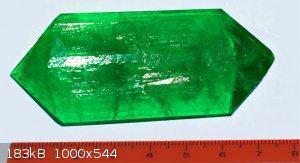Jacob K
Harmless

Posts: 5
Registered: 9-12-2020
Member Is Offline
|
|
Synthesis of Photosensitive Sodium Ferrioxalate Crystals

It is very easy for a home chemist to create beautiful and large crystals of sodium ferrioxalate using relatively simple and readily available
chemicals, and they can use the sodium ferrioxalate to study the fascinating processes of photochemistry and create blueprints (https://en.wikipedia.org/wiki/Potassium_ferrioxalate). Thus, I would recommend this project for an experienced home chemist.
To make sodium ferrioxalate, I created a procedure inspired by the one described in https://en.wikipedia.org/wiki/Sodium_ferrioxalate. I first added an excess of baking soda to aqueous ferric chloride hexahydrate (I used 12.06
grams), and I filtered out the resulting precipitate. I then added the resulting ferric hydroxide precipitate to an excess of oxalic acid, and the
ferric hydroxide dissolved in the oxalic acid, which made a rusty-brown solution. In a separate container, I made sodium oxalate by neutralizing
aqueous oxalic acid with baking soda. I then mixed the ferric oxalate solution with a slight molar excess of the resulting sodium oxalate, and a
bright emerald green solution of sodium ferrioxalate formed. I then evaporated this solution in a light-tight container, and I obtained 7.8 grams of
sodium ferrioxalate in the form of large crystals (see Figure 1), and this corresponds to a 45% yield, assuming a product formula of Na3[Fe(C2O4)3].
The steps in this process can be described by the following simplified reactions:
Reaction 1: FeCl3 (aq)+3NaHCO3 (aq)-->Fe(OH)3 (s)+3NaCl (aq)+3CO2 (g)
Reaction 2: 2Fe(OH)3 (s)+3H2C2O4 (aq)-->Fe2(C2O4)3 (aq)+6H2O (l)
Reaction 3: Fe2(C2O4)3 (aq)+3Na2C2O4 (aq)-->2Na3[Fe(C2O4)3] (s)
While my procedure successfully yielded large and beautiful crystals of product, I think it should be optimized for time efficiency and yield. This
can be done by adding the ferric chloride to 3 equivalents of aqueous oxalic acid, neutralizing the solution with 3 equivalents of sodium hydroxide or
bicarbonate (or 1.5 equivalents of sodium carbonate), and then slowly evaporating the mixture to obtain large crystals (idea from https://reactionchamber.org/sodium-ferrioxalate-complex-crys...). Although the solution would contain sodium chloride (unlike in my procedure),
the sodium ferrioxalate should crystalize out first. Furthermore, to improve yield after removing the large crystals, the solution can be fully
evaporated, and the remaining sodium ferrioxalate can be recrystallized from its mixture with sodium chloride using minimal amounts of hot water. This
procedure would be much less cumbersome than my procedure, since it can be done using a single container and with no filtration steps.

To help validate my product, I left it out in direct sunlight (see Figure 2). My product appears to be very sensitive to direct sunlight, as it turns
from transparent to translucent and then from translucent to opaque, and it turns from a light emerald green to a muddy brown. The muddy brown color
is likely due to the formation of sodium ferrooxalate and possibly other iron (II) and/or iron (III) decomposition products (https://en.wikipedia.org/wiki/Potassium_ferrioxalate). The photochemistry involved in this photodegradation is fascinating, and I would recommend
the following article for anyone interested: Chen, J.; Browne; W. R. Photochemistry of Iron Complexes. Coord. Chem. Rev. 2018, 374, 15–35.
Using just ferric chloride, baking soda, and oxalic acid, I was able to create sodium ferrioxalate and explore the phenomenon of photochemistry. I
believe that a creative home chemist may be able to use this compound to estimate the power output of the sun or perform other interesting experiments
that leverage the sodium ferrioxalate’s unique photochemistry.
|
|
|
scienceboi
Harmless

Posts: 31
Registered: 12-9-2019
Location: California
Member Is Offline
Mood: Curious
|
|
Nice write up! I might do this myself now. Thanks for sharing
"Read not to contradict and confute; nor to believe and take for granted; nor to find talk and discourse; but to weigh and consider." -Francis Bacon
|
|
|
Jacob K
Harmless

Posts: 5
Registered: 9-12-2020
Member Is Offline
|
|
Sure thing! I'm glad you liked it.
|
|
|
mayko
International Hazard
    
Posts: 1218
Registered: 17-1-2013
Location: Carrboro, NC
Member Is Offline
Mood: anomalous (Euclid class)
|
|
I had fun with this one. Behold, the forbidden hard candy!

Junk, P. C., Bacsa, J., & Thomas, N. C. (2021). Growing a Display Crystal of Recycled Potassium Tris(oxalato)ferrate(III) Trihydrate. Journal of
Chemical Education, 98(10), 3400–3404. https://doi.org/10.1021/acs.jchemed.1c00776
These folks saved ferrioxalate leftovers from years of student waste and grew an enormous high quality crystal by slow evaporation. Check out this
chonkster:

al-khemie is not a terrorist organization
"Chemicals, chemicals... I need chemicals!" - George Hayduke
"Wubbalubba dub-dub!" - Rick Sanchez
|
|
|
Lion850
National Hazard
   
Posts: 514
Registered: 7-10-2019
Location: Australia
Member Is Offline
Mood: Great
|
|
Beautiful crystal. Have to try this sometime.
|
|
|
|